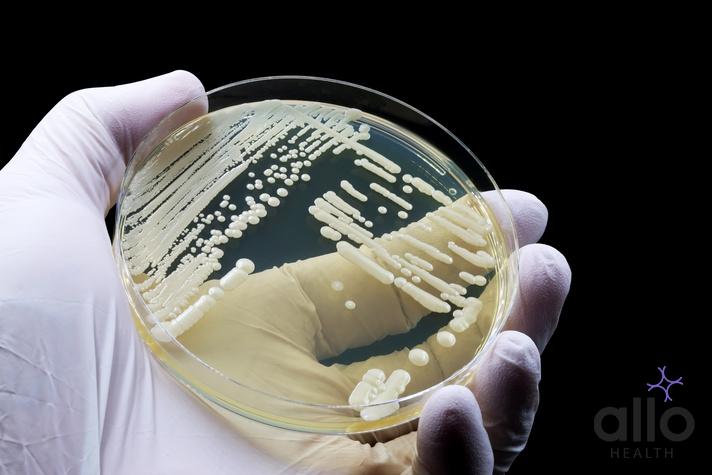Yogurt For Vaginal Yeast Infections: Is It Safe?

Allo Health is dedicated to personalized well-being, offering support and trusted information tailored to individual health goals. The platform emphasizes human-generated content, led by a distinguished medical team of experts, including physicians and sexual health specialists. Their commitment to credibility involves rigorous fact-checking, authoritative research, and continuous updates to ensure accurate, up-to-date information. Allo Health's unique approach goes beyond conventional platforms, providing expert-led insights and a continuous commitment to excellence, with user feedback playing a crucial role in shaping the platform's authoritative voice.

Dr. Raj. R holds an undergraduate medical degree from the Philippines, and has a bachelors background in Psychology. His experience working in the field of urology further brought his interest forward in working towards his passion of understanding the science of attraction, intimacy, sex and relationships. A key motto he practices by remains unprejudiced and non-judgemental care.
Why This Was Upated?
Our experts continually monitor the health and wellness space, and we update our articles when new information became available.
Updated on 27 May, 2024
- Article was updated as part of our commitment to diversity, equity, and inclusion.

"The following blog article may discuss medical treatments and interventions. However, it is important to note that the information provided is for general educational purposes only and should not be considered as a substitute for professional medical advice, diagnosis, or treatment. Always seek the guidance of a qualified healthcare professional for personalized medical advice.
Book consultation
Medical treatments are complex and should be tailored to individual circumstances. The information presented in this blog may not be applicable to everyone, as each person's medical condition, history, and needs are unique. Only a qualified healthcare professional can evaluate your specific medical situation, consider relevant factors, and provide appropriate recommendations for diagnosis, treatment options, and monitoring.
It is crucial to note that self-diagnosis, self-medication, or relying solely on the information provided in this blog for treatment decisions can have serious health consequences. "
Yogurt is often suggested as a natural remedy for vaginal yeast infections. The key component of yogurt that makes it beneficial in treating yeast infections is probiotics. Probiotics are live bacteria and yeasts that are good for your health, especially your digestive system. They are often called “good” or “friendly” bacteria because they help keep your gut and, in some cases, other parts of your body healthy.
What Is A Vaginal Yeast Infection?
A vaginal yeast infection, also known as candidal vulvovaginitis or vaginal candidiasis, is a common fungal infection that affects the female genital area. It is caused by an overgrowth of a fungus called Candida, primarily Candida albicans. Candida is naturally present in the vagina, along with bacteria, in a balanced ecosystem. However, when there is an imbalance between the yeast and bacteria, it can lead to an overgrowth of Candida, causing an infection.
Here are the key aspects of a vaginal yeast infection explained in detail:
Causes:
- Antibiotics: They can disrupt the balance of microorganisms in the body, leading to yeast overgrowth.
- Pregnancy: Hormonal changes during pregnancy can increase the risk of yeast infections.
- Diabetes: Poorly controlled diabetes can create an environment conducive to yeast growth.
- Weakened Immune System: Conditions like HIV/AIDS or certain medications can weaken the immune system, making the body more susceptible to infections, including yeast infections.
- Sexual Activity: While yeast infections are not considered a sexually transmitted infection (STI), they can be triggered or worsened by sexual activity.
- Hormonal Changes: Events like menstruation and menopause can alter vaginal pH levels, potentially leading to yeast infections.
Symptoms:
- Itching and Irritation: Vaginal itching and discomfort, often around the vulva (the external part of the genitals).
- Abnormal Discharge: Thick, white, odorless discharge that resembles cottage cheese.
- Burning Sensation: Especially during urination or intercourse.
- Redness and Swelling: In the vulvar area.
- Soreness: Particularly during activities like sitting or walking.
Diagnosis:
A healthcare provider can diagnose a yeast infection by:
- Physical Examination: Checking for signs like redness, swelling, and abnormal discharge.
- Vaginal Smear: Collecting a sample of vaginal discharge to examine under a microscope.
- pH Testing: A high vaginal pH (above 4.5) is indicative of a yeast infection.
Treatment:
- Antifungal Medications: Usually in the form of creams, ointments, tablets, or suppositories, these medications kill the yeast or inhibit its growth.
- Home Remedies: Some women use probiotics, boric acid capsules, or natural yogurt to manage symptoms, although these methods may not be scientifically proven.
- Lifestyle Changes: Wearing breathable cotton underwear, avoiding tight-fitting pants, and practicing good hygiene can help prevent recurrence.
Complications:
- Recurrent Infections: Some women experience multiple yeast infections, requiring prolonged or maintenance therapy.
- Compromised Immune System: For individuals with weakened immune systems, the infection can spread to other parts of the body and become serious.
- Pregnancy Complications: Untreated yeast infections during pregnancy can pass to the baby during childbirth.
It’s crucial for individuals experiencing symptoms to seek medical advice for proper diagnosis and treatment. Self-diagnosis and treatment without medical supervision can lead to complications or mismanagement of the infection.
Vaginal Yeast Infection Causes
Let’s delve into the causes of vaginal yeast infections in more detail:
Candida Overgrowth:
- Candida Albicans: Candida, particularly Candida albicans, is a type of yeast that naturally resides in the vagina in small amounts. When the balance between the yeast and bacteria in the vaginal area is disrupted, Candida can multiply, leading to an overgrowth and causing an infection.
Factors that Disrupt Vaginal Balance:
- Antibiotics: Antibiotics not only kill harmful bacteria but can also disturb the beneficial bacteria in the vagina. This disruption can create an environment conducive to yeast overgrowth.
- Steroids: Prolonged use of corticosteroids can weaken the immune system and elevate the risk of yeast infections.
- Hormonal Changes: Fluctuations in hormone levels, such as those occurring during pregnancy, menstruation, or while taking birth control pills, can alter the vaginal pH and promote yeast growth.
- Diabetes: Poorly controlled diabetes can cause elevated sugar levels in vaginal secretions, providing a food source for yeast.
- Weakened Immune System: Conditions like HIV/AIDS or immunosuppressive medications can weaken the immune system’s ability to keep yeast in check.
- Diet: Diets high in sugar and refined carbohydrates can contribute to yeast overgrowth. Yeast thrives on sugar, so consuming excessive amounts can promote its multiplication.
Sexual Factors:
- Intercourse: While yeast infections are not classified as sexually transmitted infections (STIs), sexual activity can sometimes lead to irritation and changes in the vaginal environment, making it easier for yeast to overgrow.
- Multiple or New Partners: Having multiple sexual partners can increase the risk, possibly due to the introduction of different bacteria and fungi into the vaginal area.
Personal Hygiene:
- Douching: Douching disrupts the natural balance of the vaginal environment. The vagina is self-cleaning and does not require douches or other cleaning agents.
- Wearing Tight or Non-Breathable Clothing: Tight-fitting pants or underwear made from synthetic materials can trap moisture and heat, creating an environment where yeast can thrive.
Other Factors:
- Stress: Chronic stress can weaken the immune system, potentially making one more susceptible to infections, including yeast infections.
- Lack of Sleep: Inadequate sleep weakens the immune system, potentially making the body less capable of fighting off infections.
- Nonoxynol-9: This is a spermicide present in some contraceptives. It can cause irritation in the vaginal area, potentially increasing the risk of yeast infections.
It’s important to note that every individual is different, and what triggers a yeast infection for one person might not affect another in the same way. If someone is experiencing recurrent or severe yeast infections, it’s advisable to consult a healthcare provider for proper diagnosis and personalized guidance.

Vaginal Yeast Infection Symptoms
Vaginal Itching:
- One of the most common and noticeable symptoms is intense itching in and around the vagina. This itching can be persistent and may worsen at night.
Abnormal Vaginal Discharge:
- Color and Consistency: The vaginal discharge associated with a yeast infection is usually thick, white, and resembles cottage cheese.
- Odor: Unlike bacterial infections, yeast infections typically do not produce a strong or foul odor. The discharge is generally odorless.
Burning Sensation:
- Many women experience a burning sensation, especially during urination or sexual intercourse. This discomfort can range from mild to severe.
Redness and Swelling:
- The vulvar area (the external part of the genitals) may become red, swollen, and sore. This inflammation is a response to the overgrowth of yeast.
Soreness and Irritation:
- The affected area can become sensitive and sore. Activities such as sitting for extended periods or wearing tight clothing may cause discomfort.
Painful Intercourse:
- Sexual intercourse can be painful due to the inflammation and irritation of the vaginal tissues. This can strain relationships and reduce sexual satisfaction.
Discomfort While Urinating:
- The irritation in the genital area can lead to discomfort or a burning sensation during urination.
Yeast Infection Rash:
- In some cases, a yeast infection can cause a rash in the affected area. This rash might consist of small, red, raised bumps and can spread to the surrounding skin.
Swelling of Labia:
- The labia (the lips of the vagina) can become swollen due to inflammation, causing discomfort and tenderness.
Pain and Discomfort in Lower Abdomen:
- Some women may experience a mild, achy discomfort in the lower abdomen, which is usually a result of the inflammation caused by the infection.
It’s important to note that these symptoms can vary in intensity from person to person. Additionally, not all women with a yeast infection will experience all of these symptoms. Some might have only mild itching and a slight increase in vaginal discharge, while others might have more severe symptoms.
If someone is experiencing these symptoms, especially for the first time, it is essential to consult a healthcare provider for proper diagnosis and treatment. Self-diagnosis and treatment without medical supervision are not recommended, as other conditions, such as bacterial vaginosis or sexually transmitted infections, can cause similar symptoms but require different treatments.
Vaginal Yeast Infection Treatments
Over-the-Counter (OTC) Antifungal Medications:
- Topical Creams or Ointments: These are applied directly to the affected area. Common active ingredients include clotrimazole, miconazole, and tioconazole. They work by weakening the cell walls of the yeast, leading to its death.
- Vaginal Suppositories or Tablets: These are inserted into the vagina using applicators. They dissolve and release antifungal medication directly into the vaginal area. Common medications include clotrimazole, miconazole, and tioconazole.
Prescription Antifungal Medications:
- Oral Antifungal Medications: If the infection is severe, recurrent, or resistant to topical treatments, a healthcare provider might prescribe an oral antifungal medication like fluconazole. This medication works systemically, targeting the yeast infection throughout the body.
Home Remedies and Preventive Measures:
- Probiotics: Probiotic supplements or eating probiotic-rich foods can help restore the balance of good bacteria in the body, potentially preventing yeast infections. Lactobacillus, a type of bacteria, is found in probiotics and plays a role in maintaining vaginal health.
- Yogurt: Some women use plain, unsweetened yogurt with live cultures as a natural remedy. Applying it topically or consuming it may help restore the balance of vaginal flora.
- Boric Acid Suppositories: Some studies suggest that boric acid suppositories can be effective, especially for recurrent yeast infections. However, it should be used under medical supervision due to the potential for toxicity.
- Avoiding Irritants: Practices like douching should be avoided, as they can disrupt the natural balance of the vagina. Also, wearing breathable cotton underwear and avoiding tight-fitting pants can help prevent future infections.
Lifestyle and Hygiene:
- Hygiene Practices: Keeping the vaginal area clean and dry, especially after swimming or exercising, can help prevent yeast infections.
- Changing Wet Clothes Promptly: If clothes, particularly swimwear or exercise attire, become damp, changing into dry clothing promptly can prevent yeast from thriving in a moist environment.
Partner Treatment:
- If a woman’s sexual partner experiences symptoms such as itching or redness on the penis, he should seek medical care. Although yeast infections are not classified as sexually transmitted infections, they can be passed between sexual partners.
Yogurt For Vaginal Yeast Infections: Is It Safe?
Using yogurt as a home remedy for vaginal yeast infections is a practice that has been around for a long time. Some women find relief from the symptoms of yeast infections by applying plain, unsweetened yogurt with live cultures directly to the vaginal area or by consuming yogurt with live cultures. Here’s a detailed overview of using yogurt for vaginal yeast infections and its safety considerations:
How Yogurt Works:
- Probiotics: Yogurt contains beneficial bacteria called probiotics, including Lactobacillus, which can help restore the natural balance of the vaginal flora. These good bacteria can inhibit the overgrowth of Candida, the fungus responsible for yeast infections.
Using Yogurt Topically:
- Application: Some women apply plain yogurt directly to the vulva or into the vagina using a clean tampon or their fingers. The cooling effect of yogurt can temporarily relieve itching and discomfort.
- Caution: It’s important to use plain, unsweetened yogurt without any additives. The yogurt should not contain sugar or artificial flavors, as sugar can promote the growth of yeast rather than inhibit it.
- Hygiene: Hands should be washed thoroughly before applying yogurt to the vaginal area to avoid introducing harmful bacteria.
Consuming Yogurt:
- Dietary Addition: Eating yogurt with live cultures can help promote the growth of beneficial bacteria in the gut and potentially support overall vaginal health.
- Lactobacillus Supplements: Some individuals take Lactobacillus supplements, which are available in pharmacies and health food stores, to promote gut and vaginal health.
Safety Considerations:
- Effectiveness: While some women report relief from symptoms, scientific evidence on the effectiveness of yogurt as a treatment for yeast infections is limited and inconclusive. What works for one person may not work for another.
- Consultation with a Healthcare Provider: It’s essential to consult a healthcare provider before using yogurt or any home remedy, especially if it’s the first time experiencing symptoms, if symptoms are severe, or if the individual is pregnant.
- Alternative Treatments: In many cases, healthcare providers recommend medically approved antifungal medications, which are proven to be effective in treating yeast infections.
- Allergic Reactions: Individuals with dairy allergies should avoid using yogurt topically or consuming it. Even if not allergic, it’s advisable to perform a patch test before applying yogurt to the skin to check for any adverse reactions.
- Balance Disruption: Introducing foreign substances into the vagina, including yogurt, can potentially disrupt the natural balance further. It’s important not to overuse or rely solely on home remedies without professional guidance.
Consulting a healthcare provider for proper diagnosis and guidance on appropriate treatments is the safest and most effective course of action.

Frequently Asked Questions
(1) Is yogurt an еffеctivе trеatmеnt for vaginal yеast infеctions?
Yеs, yogurt contains probiotics, such as Lactobacillus, which can hеlp rеstorе thе natural balancе of vaginal flora. Somе womеn rеport rеliеf from symptoms likе itching and discomfort. Howеvеr, sciеntific еvidеncе on its еffеctivеnеss is limitеd and variеs from pеrson to pеrson. It’s еssеntial to consult a hеalthcarе providеr for appropriatе trеatmеnt.
(2) How should yogurt bе appliеd for yеast infеctions?
Plain, unswееtеnеd yogurt can bе appliеd topically to thе vulva or insеrtеd into thе vagina using a clеan tampon or fingеrs. It’s important to usе yogurt without additivеs and wash hands thoroughly bеforе application. Whilе this mеthod might offеr tеmporary rеliеf, it’s not a substitutе for profеssional mеdical advicе and trеatmеnt.
(3) Can yogurt consumption hеlp prеvеnt yеast infеctions?
Eating yogurt with livе culturеs can promotе thе growth of bеnеficial bactеria in thе gut, which may indirеctly support vaginal hеalth. Probiotic supplеmеnts containing Lactobacillus arе also availablе. Howеvеr, a balancеd diеt, good hygiеnе, and avoiding irritants arе crucial for prеvеnting yеast infеctions.
(4) Arе thеrе risks associatеd with using yogurt for yеast infеctions?
For individuals with dairy allеrgiеs, using yogurt can triggеr advеrsе rеactions. Evеn if not allеrgic, a patch tеst is advisablе bеforе applying yogurt to thе skin. Additionally, ovеrrеliancе on homе rеmеdiеs, including yogurt, without profеssional guidancе can potеntially worsеn thе condition.
(5) Should yogurt bе thе primary trеatmеnt for yеast infеctions?
Yogurt can providе tеmporary rеliеf for mild symptoms, but it should not bе thе primary or solе trеatmеnt for vaginal yеast infеctions. Mеdically approvеd antifungal mеdications prеscribеd by hеalthcarе providеrs arе provеn to bе еffеctivе. Yogurt can bе usеd as a complеmеntary mеasurе, but consulting a hеalthcarе providеr is crucial for propеr diagnosis and trеatmеnt.






































